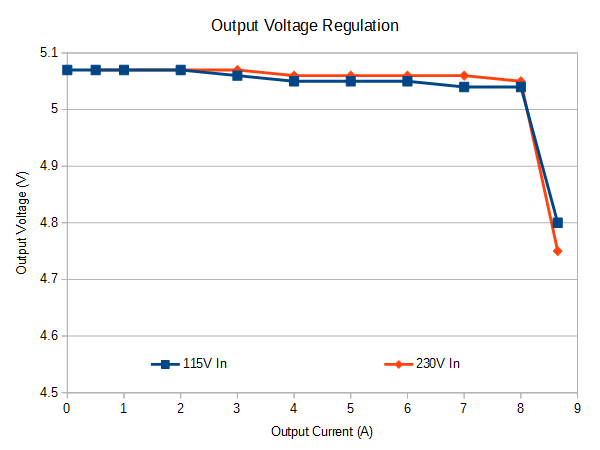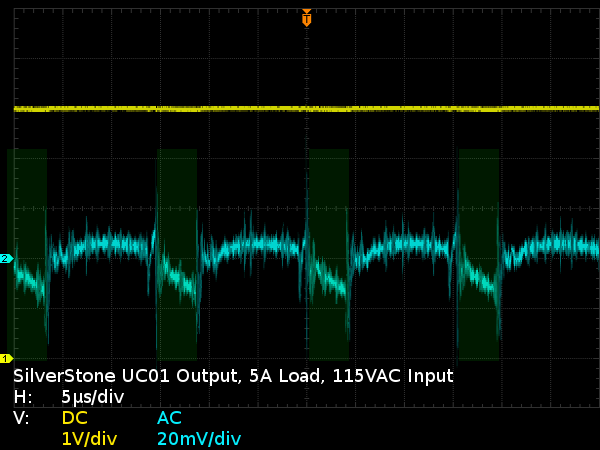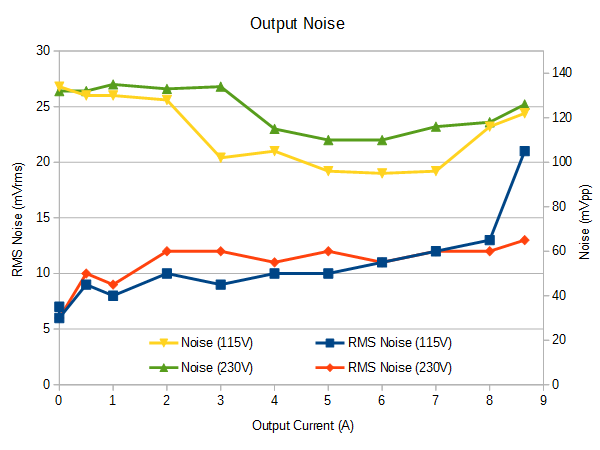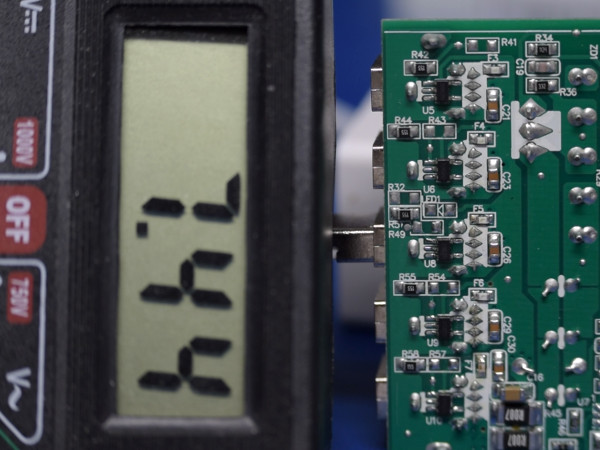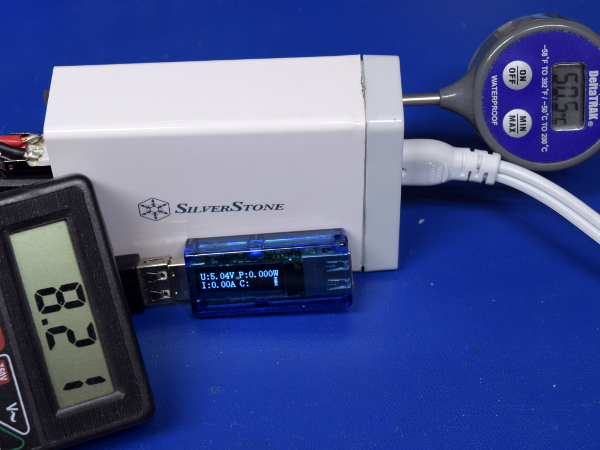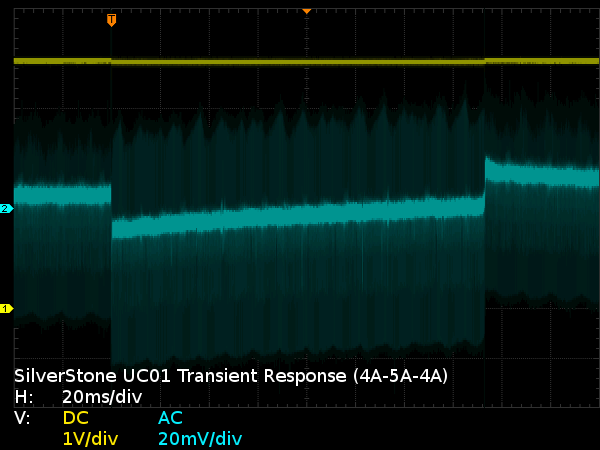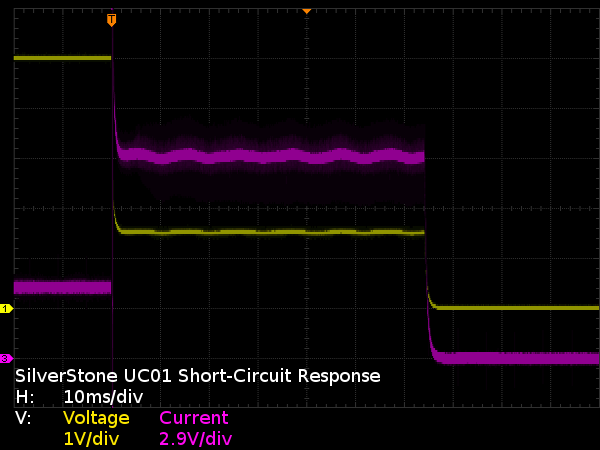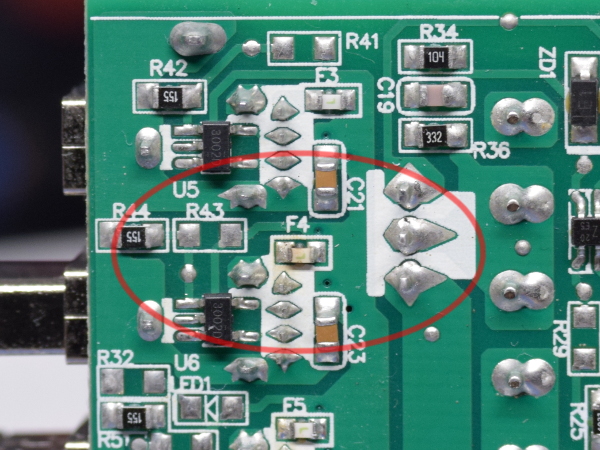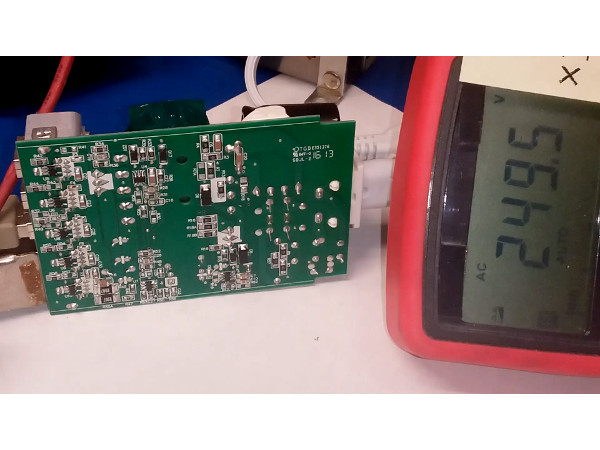Tom's Teardown: SilverStone UC01 USB Power Adapter
Output Regulation
Regardless of input voltage from 100VAC to 240VAC, regardless of running hot or cold, and regardless of output load, the output voltage remains almost perfectly flat from 5.07V open-circuit down to 5.04V at 8.6A (measured on an unloaded port to bypass fuse and heavily loaded connector voltage drops). At exactly 8.65A, again regardless of test conditions, the over-current protection kicks in and the output voltage drops rapidly to 4.8V or less.
That’s exactly the sort of output regulation and repeatable performance that should be expected from a decent-quality power supply. It's looking great so far for SilverStone’s UC01.
MORE: APC BN650M1-CA UPS Tear-Down
MORE: CyberPower EC350G Tear-Down
MORE: How (And Why) We Test USB Power Adapters
Noise Waveform
This is a typical fly-back converter waveform, albeit a cleaner one than what I was expecting from the lack of an output filter inductor. The parts highlighted in green represent when the primary-side FET is turned on and storing energy in the transformer’s magnetic field, at which point the output rectifier is reverse-biased and the transformer isn’t contributing any power to the output. When the primary turns off, energy transfer between the collapsing magnetic field and output capacitors produces those sinusoidal-looking ripples.
With the switching transients being on a sub-microsecond scale, I would be inclined to ignore peak-to-peak as a noise metric.
Get Tom's Hardware's best news and in-depth reviews, straight to your inbox.
MORE: APC BN650M1-CA UPS Tear-Down
MORE: CyberPower EC350G Tear-Down
MORE: How (And Why) We Test USB Power Adapters
Output Noise Vs. Load
While 119mVPP of average output noise may not be particularly impressive in absolute terms, it is quite decent considering that this power supply still lacks an inductor in its output filtering to soften high-frequency switching transients. On the RMS side of things, which is more representative of the actual energy contained in that noise, we’re down to a far more respectable 12mVRMS on average.
MORE: APC BN650M1-CA UPS Tear-Down
MORE: CyberPower EC350G Tear-Down
MORE: How (And Why) We Test USB Power Adapters
I’m Giving It All She’s Got Captain!
Remember that blown fuse from earlier? With no manufacturer and only one letter for markings, the only test I can perform to find out whether it blew due to a defect or user error is measuring how much current it takes to actually blow one (or trip it, if it is a polymer positive thermal coefficient device). Since the weakest PPTCs I've found in this size can still handle 30A of fault current, and the UC01 can only output 8.65A before shutting down, my bet is these are plain fuses.
So, how much current can these fuses pass? I tweaked my load’s limit to 8.5A and it was still going after 10 seconds. Under a 3x overload, an adequately-sized fuse or PPTC should open within seconds. We’ll have to consider this a fail.
MORE: APC BN650M1-CA UPS Tear-Down
MORE: CyberPower EC350G Tear-Down
MORE: How (And Why) We Test USB Power Adapters
Getting Toasty
How hot can you expect the UC01 to get while under heavy load? After completing most of my tests, I stuffed the board back in its original housing, taped a digital thermometer to its back, set my load to 8.2A, and walked away for about 15 minutes. The highest temperature it reached sitting vertically on my bench was a toasty 51°C, which would likely get worse lying flat or with any airflow obstructions nearby. I wouldn’t recommend stacking it with other devices while under heavy load.
MORE: APC BN650M1-CA UPS Tear-Down
MORE: CyberPower EC350G Tear-Down
MORE: How (And Why) We Test USB Power Adapters
Transient Load Test
How well does the UC01 cope with a 1A load swing up from and back down to 4A? Quite well actually, with a maximum deviation of about 20mV either way.
MORE: APC BN650M1-CA UPS Tear-Down
MORE: CyberPower EC350G Tear-Down
MORE: How (And Why) We Test USB Power Adapters
Short-Circuit Test
If passing 8.5A for a few seconds couldn’t blow one of the fuses, perhaps a short at the end of my #16 custom USB cable will. Upon applying the short on my test cable, the output voltage dropped to 1.6V under approximately 12A of short-circuit current, shut off after 64ms, then self-reset after about two seconds.
MORE: APC BN650M1-CA UPS Tear-Down
MORE: CyberPower EC350G Tear-Down
MORE: How (And Why) We Test USB Power Adapters
Short-Circuit Test Aftermath
I intended to do the short-circuit test using my extra leads to lessen strain on individual connectors, but initially forgot to plug them in. That means this single slightly-browned fuse carried the full 12A until I noticed a puff of smoke coming from the area. Surprisingly enough, the fuse survived. Again.
It looks like the only way to kill these fuses is an extended dead short on a USB cable with heavy-gauge wires if you don’t want the cable to become the fuse. There isn’t much of a point in having fuses if their rating is higher than the safe limits of connectors and typical cables. These really should have been PPTCs with a ~2.5A trip point at 60°C.
MORE: APC BN650M1-CA UPS Tear-Down
MORE: CyberPower EC350G Tear-Down
MORE: How (And Why) We Test USB Power Adapters
Isolation Withstand Test
And now, la pièce de résistance: the voltage withstand test. Will the UC01 make it all the way to 3.5kVAC/5kVPk? The increasingly intense crackling beyond 2kV made me nervous and I aborted the test twice to double-check that my HV wires were clear of anything they shouldn’t be touching.
Once I was certain that nothing was amiss, and that the crackling was coming from SilverStone's UC01, I proceeded to slowly raise the test voltage up to 3500VAC and hold it there for a few seconds. That’s a pass.
MORE: APC BN650M1-CA UPS Tear-Down
MORE: CyberPower EC350G Tear-Down
MORE: How (And Why) We Test USB Power Adapters
A Worthy Contender?
SilverStone’s UC01 delivered consistent results under all test conditions and load levels up to its full stated output rating, a feat made slightly more commendable by the fact that this unit has already seen over a year of moderate use. Load transient response and noise are also quite good if you overlook the narrow switching transients. The unit passed high-voltage isolation testing from input to output, meaning there is good confidence that it won’t turn into an electrocution hazard.
While I wish I could recommend the UC01, its over-sized one-time fuses put the connectors and thin-gauge cables at risk, similar to LDNIO’s adapter in my 12V round-up. If it had appropriately-sized PPTCs, it would have been a neat and safe way to replace multiple OEM adapters.
MORE: APC BN650M1-CA UPS Tear-Down
MORE: CyberPower EC350G Tear-Down
MORE: How (And Why) We Test USB Power Adapters
